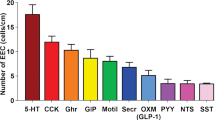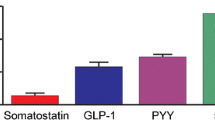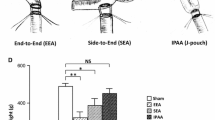Abstract
Although estrogen is implicated in the regulation of mammalian intestinal function, the presence and the distribution of estrogen receptor (ER)-positive cells in the intestine are still controversial. The present study was designed to localize ERα- and ERβ-expressing cells in female and male mouse intestines immunohistochemically under various estrogen conditions, especially in female mice, ovariectomized as well at various phases of the estrous cycle. Western blot analysis detected both ERα (66-kDa band) and ERβ (56-kDa band). Immunohistochemical staining of paraffin-embedded sections after antigen-retrieval treatment with autoclaving revealed staining for ERα in submucosal interstitial cells, and double staining identified these cells as a subtype of intestinal macrophages. The number of these cells varied according to the estrous cycle phase. Administration of 17β-estradiol to ovariectomized mice resulted in a significant increase in the number of ERα-positive macrophages. On the other hand, the nuclei of nerve cells in Auerbach and Meissner plexuses were positive for both ERα and ERβ, but the number of positive nerve cells was not affected by estrogen. Our results indicate that estrogen and estrogenic compounds may exert their actions on the intestine in two ways; one is through interstitial macrophages and the other is through intestinal neurons.






Similar content being viewed by others
References
Adams JC (1981) Heavy metal intensification of DAB-based HRP reaction product. J Histochem Cytochem 29:775
Arai N, Strom A, Rafter JJ, Gustafsson JA (2000) Estrogen receptor beta mRNA in colon cancer cells: growth effects of estrogen and genistein. Biochem Biophys Res Commun 270:425–431
Campbell-Thompson M, Lynch IJ, Bhardwaj B (2001) Expression of estrogen receptor (ER) subtypes and ER beta isoforms in colon cancer. Cancer Res 61:632–640
Ciana P, Raviscioni M, Mussi P, Vegeto E, Que I, Prker MG, Lowik C, Maggi A (2003) In vivo imaging of transcriptionally active estrogen receptors. Nat Med 9:82–86
Echeverria OM, Gonalez Maciel A, Traish AM, Wotiz HH, Ubaldo E, Vazquez-Nin GH (1994) Immuno-electron microscopic localization of estradiol receptor in cells of male and female reproductive and non-reproductive organs. Biol Cell 81:257–265
Ehara H, Koji T, Deguchi T, Yoshii A, Nakano M, Nakane PK, Kawada Y (1995) Expression of estrogen receptor in diseased human prostate assessed by non-radioactive in situ hybridization and immunohistochemistry. Prostate 27:304–313
English MA, Kane KF, Cruickshank N, Langman MJ, Stewart PM, Hewison M (1999) Loss of estrogen inactivation in colonic cancer. J Clin Endocrinol Metab 84:2080–2085
Fiorelli G, Picariello L, Martineti V, Tonelli F, Brandi ML (1999) Functional estrogen receptor beta in colon cancer cells. Biochem Biophys Res Commun 261:521–527
Foley EF, Jazaeri AA, Shupnik MA, Jazaeri O, Rice LW (2000) Selective loss of estrogen receptor beta in malignant human colon. Cancer Res 60:245–248
Heitkemper MM, Jarrett M (1992) Pattern of gastrointestinal and somatic symptoms across the menstrual cycle. Gastroenterology 102:505–513
Kaeoket K, Dalin AM, Magnusson U, Persson E (2001) The sow endometrium at different stages of the oestrous cycle: immunohistochemical study on the distribution of SWC3-expressing cells (granulocytes, monocytes, and macrophages). J Vet Med A Physiol Pathol Clin Med 48:507–511
Koji T, Brenner RM (1993) Localization of estrogen receptor messenger ribonucleic acid in rhesus monkey uterus by nonradioactive in situ hybridization with digoxigenin-labeled oligodeoxynucleotide. Endocrinology 132:382–392
Kuiper GG, Enmark E, Pelto-Huikko M, Nilsson S, Gustafsson JA (1996) Cloning of a novel estrogen receptor expressed in rat prostate and ovary. Proc Natl Acad Sci U S A 93:5925–5930
Laemmli UK (1970) Cleavage of structural proteins during the assembly of the head of bacteriophage T4. Nature 227:680–685
Mara Suburo A, Chaud M, Franchi A, Polak JM, Gimeno MA (1995) Distribution of neuronal and non-neuronal NADPH diaphorases and nitric oxide synthases in rat uterine horns under different hormonal conditions. Biol Reprod 52:631–637
Marquez DC, Pietras RJ (2001) Membrane-associated binding sites for estrogen contribute to growth regulation of human breast cancer cells. Oncogene 20:5420–5430
Mary LT, Xiaomeng XU, Andrea MN, Cheryl SW (1993) The presence of functional estrogen receptors in intestinal epithelial cells. Endocrinology 132:426–430
Mitchner NA, Garlick C, Ben-Jonathan N (1998) Cellular distribution and gene regulation of estrogen receptors alpha and beta in the rat pituitary gland. Endocrinology 139:3976–3983
Nakayama Y, Sakamoto H, Satoh K, Yamamoto T (2000) Tamoxifen and gonadal steroids inhibit colon cancer growth in association with inhibition of thymidylate synthase, survivin and telomerase expression through estrogen receptor beta mediated system. Cancer Lett 161:63–71
Nishihara E, Nagayama Y, Inoue S, Hiroi H, Muramatsu M, Yamashita S, Koji T (2000) Ontogenetic changes in the expression of estrogen receptor α and β in rat pituitary gland detected by immunohistochemistry. Endocrinology 141:615–620
Oduwole OO, Isomaa VV, Nokelainen PA, Stenback F, Vihko PT (2002) Downregulation of estrogen-metabolizing 17 beta-hydroxysteroid dehydrogenase type 2 expression correlates inversely with Ki67 proliferation marker in colon-cancer development. Int J Cancer 97:1–6
Paech K, Webb P, Kuiper GG, Nilsson S, Gustafsson J, Kushner PJ, Scanlan TS (1997) Differential ligand activation of estrogen receptors ERα and ERβ at AP1 sites. Science 277:1508–1510
Pelletier G, El-Alfy M (2000) Immunocytochemical localization of estrogen receptors alpha and beta in the human reproductive organs. J Clin Endocrinol Metab 85:4835–4840
Qui Y, Waters CE, Lewis AE, Langman MJ, Eggo MC (2002) Oestrogen-induced apoptosis in colonocytes expressing oestrogen receptor beta. J Endocrinol 174:369–377
Shah S, Nathan L, Singh R, Fu YS, Chaudhuri G (2001) E2 and not P4 increases NO release from NANC nerves of the gastrointestinal tract: implications in pregnancy. Am J Physiol 280:1546–1554
Singh S, Poulsom R, Hanby AM, Rogers LA, Wright NA, Sheppard MC, Langman MJ (1998) Expression of oestrogen receptor and oestrogen-inducible genes pS2 and ERD5 in large bowel mucosa and cancer. J Pathol 184:153–160
Smirnoff P, Liel Y, Gnainsky J, Shany S, Schwartz B (1999) The protective effect of estrogen against chemically induced murine colon carcinogenesis is associated with decreased CpG island methylation and increased mRNA and protein expression of the colonic vitamin D receptor. Oncol Res 11:255–264
Tsurusaki T, Aoki D, Kanetake H, Inoue S, Muramatsu M, Hishikawa Y, Koji T (2003) Zone-dependent expression of estrogen receptors α and β in human benign prostatic hyperplasia. J Clin Endocrinol Metab 88:1333–1340
Verdu EF, Deng Y, Bercik P, Collins SM (2002) Modulatory effects of estrogen in two murine models of experimental colitis. Am J Physiol 283:27–36
Wang H, Eriksson H, Sahlin L (2000) Estrogen receptors alpha and beta in the female reproductive tract of the rat during the estrous cycle. Biol Reprod 63:1331–1340
Wiggins JP, Rothenbacher H, Wilson LL (1980) Histologic evaluation of the effects of diethylstilbestrol and zeranol on certain lamb tissues. Am J Vet Res 41:487–492
Witte D, Chirala M, Younes A, Li Y, Younes M (2001) Estrogen receptor beta is expressed in human colorectal adenocarcinoma. Hum Pathol 32:940–944
Yoshinaga K, Hawkins RA, Stocker JF (1969) Estrogen secretion by the rat ovary in vivo during the estrous cycle and pregnancy. Endocrinology 85:103–112
Author information
Authors and Affiliations
Corresponding author
Rights and permissions
About this article
Cite this article
Kawano, N., Koji, T., Hishikawa, Y. et al. Identification and localization of estrogen receptor α- and β-positive cells in adult male and female mouse intestine at various estrogen levels. Histochem Cell Biol 121, 399–405 (2004). https://doi.org/10.1007/s00418-004-0644-6
Accepted:
Published:
Issue Date:
DOI: https://doi.org/10.1007/s00418-004-0644-6




